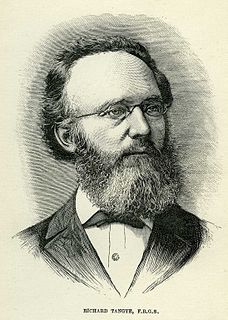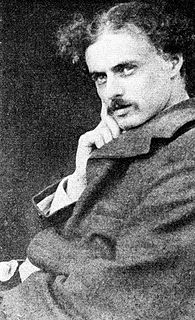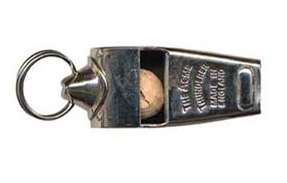
A whistle is an instrument which produces sound from a stream of gas, most commonly air. It may be mouth-operated, or powered by air pressure, steam, or other means. Whistles vary in size from a small slide whistle or nose flute type to a large multi-piped church organ.

The title of Earl of Ulster has been created six times in the Peerage of Ireland and twice Peerage of the United Kingdom. Since 1928, the title has been held by the Duke of Gloucester and is used as a courtesy title by the Duke's eldest son, currently Alexander Windsor, Earl of Ulster. Ulster, one of the four traditional provinces of Ireland, consists of nine counties, six of which make up Northern Ireland, the remainder are in Ireland.

Sir John de Courcy was an Anglo-Norman knight who arrived in Ireland in 1176. From then until his expulsion in 1204, he conquered a considerable territory, endowed religious establishments, built abbeys for both the Benedictines and the Cistercians and built strongholds at Dundrum Castle in County Down and Carrickfergus Castle in County Antrim.

Sir Richard Trevithick Tangye was a British manufacturer of engines and other heavy equipment.
Birmingham is one of England's principal industrial centres and has a history of industrial and scientific innovation. It was once known as 'city of a thousand trades' and in 1791, Arthur Young described Birmingham as "the first manufacturing town in the world". Right up until the mid-19th century Birmingham was regarded as the prime industrial urban town in Britain and perhaps the world, the town's rivals were more specific in their trade bases. Mills and foundries across the world were helped along by the advances in steam power and engineering that were taking place in the city. The town offered a vast array of industries and was the world's leading manufacturer of metal ware, although this was by no means the only trade flourishing in the town.
The Acme siren is a musical instrument used in concert bands for comic effect. Often used in cartoons, it produces the stylized sound of a police siren. It is one of the few aerophones in the percussion section of an orchestra.
Charles de Courcy Parry CBE was a British police officer who served as Chief Constable of the Cumberland and Westmorland Constabulary from 1902 to 1920 and in 1927 was appointed His Majesty's Inspector of Constabulary for Wales.
Joseph Hudson (1848–1930) was an inventor in Birmingham, England during the late 19th century and the founder of J Hudson & Co in 1870, later to become the world largest whistle manufacturer.

Bernard Sleigh was an English mural painter, stained-glass artist, illustrator and wood engraver, best known for his work An Ancient Mappe of Fairyland, Newly Discovered and Set Forth, which depicts numerous characters from legends and fairytales. A copy of The Ancient Mappe is in the Library of Congress in Washington, D.C. He was a member of the Royal Birmingham Society of Artists between 1923 and 1928.
Cecil Charles Hudson Moriarty, (1877–1958) was an Irish-born British police officer and Irish rugby international. He won one cap against Wales in 1899. He served as Chief Constable of Birmingham from 1935 to 1941, and his manuals and books on police procedures became essential guidebooks for police in the United Kingdom.
J Dixon & Sons founded 1806 in Sheffield, was one of the major British manufacturers in the Industrial Revolution of the 19th century. They were well known as manufacturers of Pewterware, Electroplated Britannia metal see ,Silverware and Electroplated nickel silver. Their products included hundreds of items for use in the kitchen and the dining room(e.g. tea services, cocktail shakers and mixers) as well as items like candlesticks for all rooms. They were a world leader in manufacturing shooting accessories through nineteenth century and exported powder flasks in large quantities to America, They were known as whistle makers, which like most of their products were of outstanding quality; they were one of the 4 great whistle makers, the others being W Dowler & Sons, J Stevens & Son & T Yates.
Henry Arthur Ward (1838-1903) was a Birmingham whistle maker who made whistles of high quality, all rare and hard to find. He made whistles from 1876 to 1903.
Sampson Mordan was a British silversmith and a co-inventor of the first patented mechanical pencil. During his youth, he was an apprentice of the inventor and locksmith Joseph Bramah, who patented the first elastic ink reservoir for a fountain pen.
The City of London market constabularies are three small constabularies responsible for security at Billingsgate, New Spitalfields and Smithfield markets run by the City of London Corporation.
Joseph Gillott's is a company based in Birmingham, England, which has been manufacturing high-quality dip pens since 1827. The company is currently part of William Mitchell Ltd.

Alfred Herbert Richardson (1874–1951) was an English policeman. He joined the Birmingham City Police in 1890. He achieved very rapid promotion within this force and in 1901 became Chief Constable of Newcastle-under-Lyme, Staffordshire. In 1903 he successfully applied for the Chief Constable's office at Halifax, West Riding of Yorkshire, where he remained until his retirement in 1944. During his time there he achieved many early improvements in policing at Halifax, some of which were later used nationwide. The most notable were the installing of coloured lights as traffic signals at road junctions, the formalisation of procedures for police identity parades, making 'keep left' mandatory for traffic and the installation of police telephones in the town, among others. In later years he was recognized as being a policeman who was ahead of his time. He came from a police family: his father, Frank Richardson (1851–1938), was the Chief Constable of Hereford from 1882 until 1920, and his elder brother, Ernest Frank Richardson (1871–1952), served as Chief Constable of Salisbury between 1903 and 1929. Thus three members of the Richardson family served as chief constables between 1902 and 1920. He also had three other brothers who served in other police forces.
The New Year Honours 1926 were appointments by King George V to various orders and honours to reward and highlight good works by members of the British Empire. They were published on 29 December 1925.











